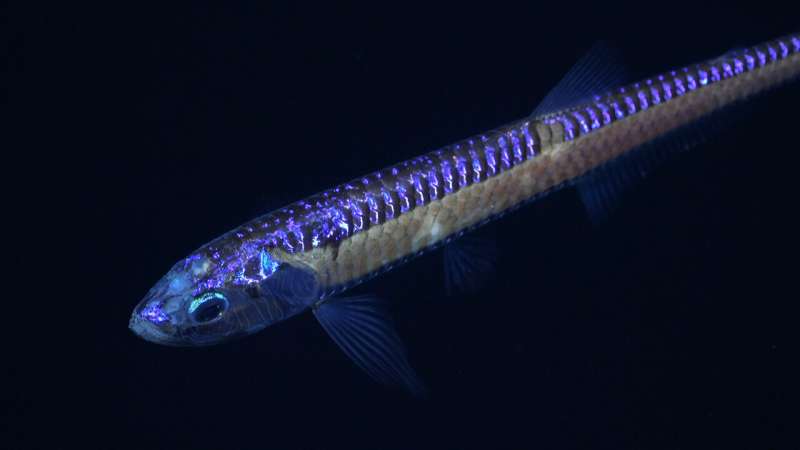
An international group of scientists, co-led by researcher Ariadna Mechó of the Barcelona Supercomputing Center—Centro Nacional de Supercomputación (BSC-CNS), observed 160 species on seamounts off the coast of Chile that had not yet been known to live in the region and suspect that at least 50 of these species are new to science.
The recent Schmidt Ocean Institute expedition to the underwater mountains of the Salas y Gómez Ridge, a remote and underexplored area that stretches from offshore Chile to Rapa Nui, resulted in identifying deep-sea corals, glass sponges, sea urchins, squids, fishes, mollusks, crabs, sea stars, squat lobsters, and other species likely never-before observed by scientists.
Mechó, a researcher in the Climate Variability and Change group at the BSC’s Earth Sciences Department, presented the results of the 40-day scientific cruise “Unexplored Seamounts of the Salas y Gómez Ridge” and the current negotiations to create a blue corridor in the area at the “Ocean Decade MPA Forum: Progress, obstacles and solutions,” an off-site event organized in the framework of the UN Ocean Decade Conference held in Barcelona from 10–12 April 2024.
“The main results of this campaign are that we have found between 50 and 60 potentially new species at first sight, a number that is likely to increase as we have many samples to work on in the laboratory.
“We also found one of the deepest mesophotic corals in the world, extending the distribution of this Polynesian fauna by several hundred kilometers. And at depth, we have found fields of sponges and corals, habitats that are considered vulnerable and in need of protection,” said Mechó.

The expedition took place from 24 February to 4 April with an international team of 25 scientists from 14 organizations in five countries (Chile, United States, Italy, Spain, Netherlands), including the first Rapa Nui marine biologist, Emilia Ra’a Palma Tuki, a recent graduate of the Universidad Católica del Norte in Chile.
The Rapa Nui Sea Council, or Koro Nui o te Vaikava, supported the expedition, providing the main permit to work in the area, and collaborated by providing a Koro Nui observer and a local sailing expert to bring to the expedition their perspectives as members of the Rapa Nui community.
The information collected during this research expedition will provide the scientific basis to inform the management of existing marine protected areas and potentially expand them, especially around the island of Rapa Nui.
One of the most unexplored areas of the planet
The cruise is devoted to studying the ecosystems of one of the most unexplored areas of the world, the submarine mountains and oceanic islands of the Salas y Gómez Ridge, which is a 2,900-kilometer-long underwater mountain chain comprising more than 200 seamounts from offshore Chile to Rapa Nui, otherwise known as Easter Island (or Isla de Pascua).

This ridge hosts one of the most unique and biodiverse seascapes on Earth, with an extremely high rate of endemism, critical habitats for benthic organisms, essential migration corridors for highly mobile species, and the presence of over 80 threatened or endangered species.
In addition, the Salas y Gómez Ridge possesses a rich cultural and maritime heritage with profound connections to Indigenous islander and mainland communities and other nations. This remote, underexplored region likely harbors pristine and unexploited habitats with abundant biodiversity that require international cooperation to protect them before they are lost.
Modeling the ocean with supercomputing
The role of BSC and supercomputing in the campaign is to provide climate modeling data through different scenarios to establish the distribution of key species in the area. This will help us understand how these species will be impacted by future changes, depending on each possible scenario.
“But first, we need to better understand the biodiversity and connectivity of the region to know which keystone species are found there and on which mountains exactly, as well as potential faunal breaks (where communities change or stop connecting with each other). Basically, it is a unique exploration in places where practically everything is unexplored,” said Mechó.
The aim is to provide the critical information to support the designation of the Salas y Gomez Ridge as an ecologically and biologically significant marine area (EBSA) by the Convention on Biological Diversity and an ecological and socioeconomic “priority area” for international protection, by the High Seas Treaty.
This cruise was strongly connected with an earlier campaign deployed between January and February 2024 and focused on studying the junction between the Salas y Gomez and the Nazca Ridge, and the Desventuradas Islands.
During the two cruises, more than 100 new species have been discovered on the Salas y Gomez and the Nazca Ridge (SyGR), as well as coral and sponge gardens. That will emphasize the need for a blue corridor along the Salas y Gómez and Nazca Ridges, creating one of the first and larger high-seas marine protected areas in the world.
Citation:
Research team discovers more than 50 potentially new deep-sea species in one of the most unexplored areas of the planet (2024, April 12)
retrieved 12 April 2024
from https://phys.org/news/2024-04-team-potentially-deep-sea-species.html
This document is subject to copyright. Apart from any fair dealing for the purpose of private study or research, no
part may be reproduced without the written permission. The content is provided for information purposes only.







